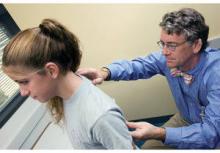WASHINGTON – Normal variations of the lower extremities in healthy children can be worrisome for parents, but they "virtually never" need to be treated in the first decade of life, Dr. William Phillips said.
These normal variations – which include intoeing and bowlegs – often lead to unnecessary referrals and treatments, said Dr. Phillips, chief of the orthopedic service and the orthopedic surgery clinic at Texas Children’s Hospital, Houston.
What is normal can vary with age, and usually resolves without any treatment, he said at a practical pediatrics meeting sponsored by the American Academy of Pediatrics.
Families can be reassured that it can take a few years, not months, for intoeing to improve. "The natural history of intoeing of any cause is that it gradually gets better," usually by age 8-10 years, he said, pointing out that 30% of 6-year-olds have intoeing, compared with less than 5% of adults. And only in rare cases is any treatment recommended, he said.
The Denis Browne bar (now used only for clubfoot) or special shoes are not effective; the only effective treatment is a derotation osteotomy, which he usually does not recommend, although he does perform this surgery for children with cerebral palsy.
The common causes of intoeing or out-toeing are metatarsus adductus, internal or external tibial torsion, or excessive femoral anteversion. Evaluating the torsional profile while the child is in a prone position makes it easier to identify these conditions; this includes looking at the lateral border of the foot, the thigh-foot angle, and hip rotation, said Dr. Phillips, who also is a professor of pediatrics at Baylor College of Medicine, Houston.
The lateral border of the foot is normally straight, but if it appears to be "bean-shaped," the child has metatarsus adductus, he noted. At the thigh-foot angle, most children have some external tibial torsion, but if the line from the second toe to the heel is pointing outward instead of inward, the child has internal tibial torsion.
A child with a normal exam with normal variations should be checked for short stature. If under the fifth percentile for age, he or she is more likely to have an underlying problem such as a skeletal dysplasia. It also helps to observe how the child stands, walks, and runs when barefoot and in shorts. Other factors that should be considered include family history and whether the child was full term or a breech delivery, as well as whether he or she is meeting developmental milestones and whether the intoeing is causing functional problems, Dr. Phillips added. Radiographs are not very helpful when evaluating children with intoeing.
Metatarsus adductus typically resolves spontaneously, and while it is occasionally treated with serial casting, this is not usually necessary, said Dr. Phillips, who has not recommended special shoes for these patients for many years.
Internal tibial torsion is seen in toddlers and also improves with time, although it often persists longer in children who have a tendency to sleep in a position similar to a fetal position, which delays remodeling, he said.
Children with external tibial torsion, which is much less common, tend to be awkward, clumsy runners. The only treatment for this is an osteotomy, which he usually does not recommend.
Excessive or increased femoral anteversion is most commonly seen in younger children, who present with an intoed gait that tends to get worse when they are tired; these children also tend to sit in a "W" position. Another sign of increased femoral anteversion is "kissing patellae" when a child lies down, Dr. Phillips said. There is no evidence that increased femoral anteversion increases the risk of osteoarthritis, although it can cause problems with the kneecap in a few cases – but not until adolescence, he added.
For children with intoeing, he recommends activities "where they can’t get very far if they turn their feet in all the way," such as roller and ice-skating, skiing, and ballet.
The wide range of normal variations of the lower extremities in children includes bowlegs and knock-knees, which are angular variations, Dr. Phillips said, pointing out that children at different ages have different alignments to their limbs. In the first year and a half, children tend to be bowlegged, followed by a "hyper–knock-kneed" phase, and, subsequently, their legs straighten out and they are mildly knock-kneed, he added.
But if a child is still bowlegged at age 3 years, however, he starts to investigate further.
He recommends radiographs for children with bowlegs or knock-knees when they are under the fifth percentile, because they are more likely to have a problem like skeletal dysplasia, and when there is a positive family history or they have an asymmetrical or worsening deformity. A special x-ray – a standing AP from the hips to the ankles – helps evaluate alignment as the child is standing with the kneecaps straight ahead.


